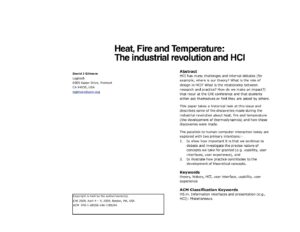The Industrial Revolution is not a topic which comes up frequently at CHI conferences and if it does it is more likely to be in relation to the scale of the social impact, rather than in relation to the development of our profession.
And yet, the Industrial Revolution was a time of great engineering and scientific achievement, increased productivity as well as massive social changes and disruption. There were pressures on production that required better and better machinery and movements of people that changed traditions of food production and delivery. And all this at a time when weaponry was advancing, empires were growing and wars were occurring on a larger scale.
There are many things we might learn today from that time – some of them obvious such as ‘lets not forget the importance of human considerations as well as economic ones” and others less obvious, such as the complex relationship between science, theory and practice.
It is this latter area that I wish to explore in this paper. In particular the events, people and activities that were to give rise to the area of thermodynamics. In exploring this area we will not only see how the distinctions between theory and practice played out (distinctions that impede the progress of HCI today), but we may also gain a clearer sense of some key missing elements in HCI theory.
The Industrial Revolution is not a topic which comes up frequently at CHI conferences and if it does it is more likely to be in relation to the scale of the social impact, rather than in relation to the development of our profession.
And yet, the Industrial Revolution was a time of great engineering and scientific achievement, increased productivity as well as massive social changes and disruption. There were pressures on production that required better and better machinery and movements of people that changed traditions of food production and delivery. And all this at a time when weaponry was advancing, empires were growing and wars were occurring on a larger scale.
There are many things we might learn today from that time – some of them obvious such as ‘lets not forget the importance of human considerations as well as economic ones” and others less obvious, such as the complex relationship between science, theory and practice.
It is this latter area that I wish to explore in this paper. In particular the events, people and activities that were to give rise to the area of thermodynamics. In exploring this area we will not only see how the distinctions between theory and practice played out (distinctions that impede the progress of HCI today), but we may also gain a clearer sense of some key missing elements in HCI theory.
